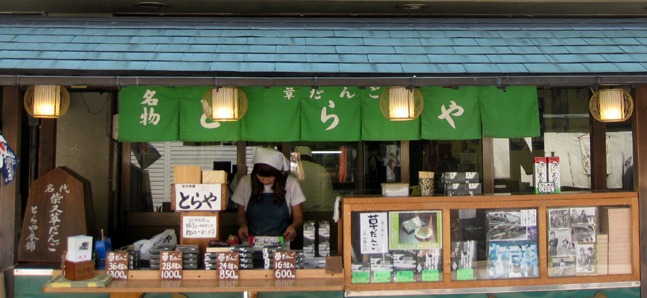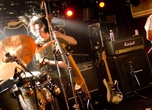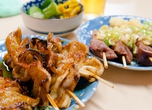Area Feature: Shibamata
A blast from the Showa past

Toraya
Posted: Mon Oct 19 2009
Shibamata is perhaps most famously known as the hometown of Tora-san, the iconic, unlucky-in-love character whose adventures in the 1969-1995 movie series Otoko wa Tsurai yo (lit. 'It's Tough Being a Man') captured the hearts of many.
True to form, a bronze statue of hometown-man Tora-san awaits just outside Shibamata station. Follow his stare straight to the tourist information centre, where copies of the Katsushika Sightseeing Guide Map are available to help you get situated. Nearby stands a statue that serves as a memorial to Ritsuko, a five-year-old girl brutally killed by her father in 1932.
This dark memorial aside, Shibamata is all about nostalgia for the simple life. Full of Japanese gardens, parks and temples, Shibamata's Showa atmosphere encourages people to take it easy and revisit a time when things went a bit slower.
Walking through Taishakuten Sando, a street lined with traditional shops, you might be tempted by a dizzying array of Japanese snacks, including soba. Freshly milled soba flour can also be bought from soba restaurant Uguisuan Yabuchu so you can try your hand at making soba-based delights at home. Soba aside, Shibamata’s most iconic food offering is dango, the tender rice flour dumplings boiled or grilled and served on a stick with sweet or savoury toppings. Try kusadango, the ubiquitous green dango, served with green tea.
If dango is what you’re after, then head forToraya which featured as Tora-san's dango shop during the first four 'Tora-san' movies. Subsequent films used a set modelled on the Kameya Honpo dango shop down the road. Tora-san aficionados can also experience the original movie sets at the Tora-san Museum. Keep an eye out for the wandering Tora-san look-a-like who will be more than happy to stop and chat. Although a touch slimmer than the original, don't miss out on the photo opportunity.
Also on Taishakuten Sando, Rakugaki Kobo supplies hand-printed fabrics and coasters featuring assorted Japanese family crests. Blasts from the Showa past can be found at Haikara Yokocho, a shop packed with retro paraphernalia. Most Japanese toys made during the Showa era come from the local area, and upstairs, Haikara Yokocho has dedicated a museum to such toys.
At the end of Taishakuten Sando lies Taishakuten Temple. The temple is vast, complete with a gallery and Japanese-style garden. If you’re looking for a bit of spiritual purification, you might want to visit the statues of a deity that's said to cleanse you of your sins if you wash it.
If you’re looking for a bit of a rest, try the short boat ride across the Edo River using the Yagiri no Watashi ferry service, in operation since the beginning of the seventeenth century. The other side of the river doesn't offer much apart from an impressive view, so snacks, drinks and a picnic blanket are recommended if wanting to spend any time there.
According to a man who makes wara straw accessories by the riverside, the sign warning about snapping turtles apparently floated downstream one day and the ferry operators decided to display it anyhow. There are, however, many turtles and fish in the river so it might pay to keep your fingers out of the water.
For those looking to maximise their nature-intake can also rent bicycles and ride along the river to Mizumoto Park.
Most shops and museums are open on weekends and public holidays. Information in English is scarce, as Shibamata is mainly popular with Japanese tourists. Be prepared for a mainly Japanese-language environment. Don’t let this deter you, though, as Shibamata truly is a blast from the past giving visitors a slice of Showa heaven.
Shibamata is only a 15 minute train ride from Nippori on the JR Yamanote line, making it a perfect day trip to get a breather from the city. From Nippori, take the Keisei Line to Keisi Takasago station, transferring to the Keisei Kanamachi line to Shibamata station.
- Uguisuan Yabuchu Soba
- Address: 7-7-8 Shibamata, Katsushika-ku
- Telephone: (03)3657 8568
- Website: yabuchu.fc2web.com/
- Toraya Dango
- Address: 7-7-5 Shibamata, Katsushika-ku
- Telephone: (03)3659 8331
- Website: www.toraya.info/
- Kameya Honpo Dango
- Address: 7-7-9 Shibamata, Katsushika-ku
- Telephone: (03)3657 6670
- Website: www.kameyahonpo.com/
- Tora-san Museum
- Address: 6-22-19 Shibamata, Katsushika-ku
- Telephone: (03)3657 3455
- Website: www.katsushika-kanko.com/tora/
- Rakugaki Kobo
- Address: 7-1-16 Shibamata, Katsushika-ku
- Telephone: (03)5579 7783
- Website: katsusikakankou.com/Katsusikakankou/mapsinmeikai/shop/rakugaki.html
- Haikara Yokocho
- Address: 7-3-12 Shibamata, Katsushika-ku
- Telephone: (03)3673 2256
- Website: www2.odn.ne.jp/shibamata/
- Taishakuten Temple
- Address: 7-10-3 Shibamata, Katsushika-ku
- Telephone: (03)3657 2886
- Website: taishakuten.or.jp/
- Yagiri no Watashi Ferry
- Address: 7-18 Shibamata, Katsushika-ku
- Telephone: (047)363 9357
- Website: www.katsushika-kanko.com/katsumaru/area/shibamata03/
- Bicycle Rental Centre
- Address: Tora-san Museum
- Telephone: (03)3657 3455
- Website: www.katsushika-kanko.com/2_shibamata/2_3_1.html
- Mizumoto Park
- Address: 3-2 Mizumoto Koen, Katsushika-ku
- Telephone: (03)3607 8321
- Website: www.kensetsu.metro.tokyo.jp/kouen/kouenannai/park/mizumoto.html
Tags:
Tweets
- About Us |
- Work for Time Out |
- Send us info |
- Advertising |
- Mobile edition |
- Terms & Conditions |
- Privacy policy |
- Contact Us
Copyright © 2014 Time Out Tokyo














Add your comment